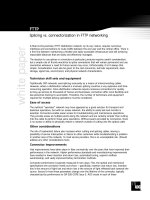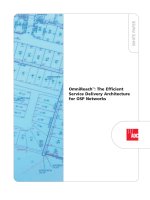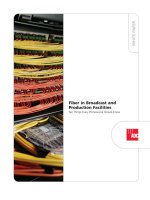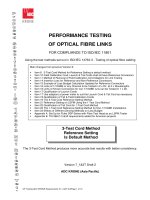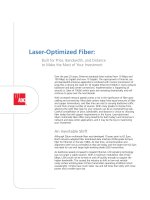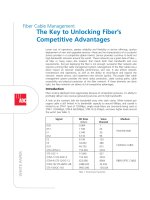Tài liệu ADC KRONE - Guide Book - FTTP - Advantage of Centralized Splitters in FTTP networks doc
Bạn đang xem bản rút gọn của tài liệu. Xem và tải ngay bản đầy đủ của tài liệu tại đây (567.59 KB, 5 trang )
Advantage of Centralized
Splitters in FTTP Networks
WHITE PAPER
In today’s and tomorrow’s fiber-to-the-premises (FTTP) architectures, the best solution for
offering multiple services to subscribers will be the one that is the most cost effective,
flexible, and scalable. With its 65-year history of innovative solutions for managing the
physical cable plant, ADC is bringing all its experience to bear in the outside plant (OSP)
and fiber-to-the-premises (FTTP) markets. Driven by the customer’s need for overall
affordability and operational flexibility, ADC is designing and building the first true FTTP
solution – from the ground up.
A major consideration in building the fiber distribution portion of the network – the link
between customer and central office – is which optical splitter approach will work best.
Since today’s optical line terminal (OLT) card can service a maximum of 32 customers, it is
important to ensure efficient use of each card. In large developments, inefficient use of
OLT cards costing about $5000 each can quickly increase initial deployment costs. Of
equal importance is the network’s ability to adapt to future technological changes as the
telecommunication industry continues to mature.
The two common splitter configurations are the centralized and the cascaded
approaches. The centralized splitter approach typically uses a 1x32 splitter in an outside
plant (OSP) enclosure, such as a fiber distribution terminal. In the case of a 1x32 splitter,
each device is connected to an OLT in the central office. The 32 split fibers are routed
directly from the optical splitter through distribution panels, splice points and/or access
point connectors, to the optical network terminals (ONTs) at 32 homes.
The cascaded splitter approach is normally configured with a 1x4 splitter residing in the
OSP enclosure and connected directly to an OLT in the central office. Each of the four
fibers leaving the 1x4 splitter is routed to an access terminal housing another splitter,
either a 1x4 or 1x8. Optimally, there would eventually be 32 fibers reaching the ONTs of
32 homes.
Advantage of Centralized Splitters
in FTTP Networks
1x4 or 1x8
Splitter
Central Office
OSP
Enclosure
1x4 or 1x8 Splitters
1x4 or 1x8 Splitters
FTTP Cascaded Optical Splitter Network Diagram
Advantage of Centralized Splitters in FTTP Networks
Page 2
Central Office
up to
1xN Splitter
(N up to 32)
FTTP Centralized Optical Splitter Network Architecture
OLT Efficiency
For most applications, ADC recommends the centralized
approach because of several significant benefits. First and
foremost, the centralized approach maximizes the
highest efficiency of expensive OLT cards. Since each
home in this approach is fiber-connected directly back to
a central hub, there are no unused ports on the OLT card
and 100% efficiency is achieved. This also allows a much
wider physical distribution of the OLT ports – extremely
important when initial “take rates” are projected to be
low to moderate.
A cascaded splitter approach requires dedicating 32
fibers from a single 1x4 or 1x8 configuration back to the
central office. This requires homes to be in the same
physical vicinity because they must tap into access
terminals that are linked together. Without a very high
service take rate, many of these fibers or ports could be
stranded. This approach absolutely requires a guarantee
of high take rates in order to efficiently use every OLT
port.
For example, let’s look at a typical 128-home
neighborhood. Service to each home would require the
purchase of four PON cards and all the necessary splitters
to ensure service through the cascaded and dedicated
1x4 or 1x8 splitters. However, a centralized 1x32 splitter
approach would provide services with a single PON card
and one splitter to the first 32 homes, regardless of their
physical location. As revenue is generated and more
homes desire service, an additional PON card can be
purchased to add each additional 32 homes as the
system grows, with no stranded, unused fiber runs.
When this method is scaled to many new greenfield or
city overbuilds with hundreds or thousands of homes
passed, it’s easy to see the economical differences
between the two methods, particularly in terms of
additional PON card requirements of a cascaded system.
Even if a service provider is expecting take rates of 90%
or higher, that rate may not be fully realized for several
years. By delaying the capital purchased until additional
customers subscribe, the service provider can save
money. Even in a greenfield deployment expecting 100%
take rate, there are considerations to keep in mind
before choosing a cascaded approach, even though it
works best in high take rate situations.
For example, MSOs might be building that same
subdivision to offer voice services, diluting the take rate
figure to something less than 100%. Additionally, if the
subdivision is built over a period of several years, there
could be a wide diversity of take rate times as houses are
actually built and occupied many months apart. If this is
the case, some ports could be stranded as much as a
year or more, tying up capital that could be better spent
elsewhere in the project.
Advantage of Centralized Splitters in FTTP Networks
Page 3
Network Testing Ability
The second benefit of a centralized splitter approach is
its ability to provide easy testing and troubleshooting
access. It is very difficult to use an optical time-domain
reflectometer (OTDR) to test multiple splitters unless the
network is built with each fiber characterized to enable
the OTDR to recognize each individual fiber run. From a
centralized point, it’s nearly impossible to “see” down
individual fiber lengths through a series of splitters.
A centralized splitter configuration, on the other hand,
provides one centralized hub for truck rolls to
troubleshoot instead of two or more. Another benefit is
in terms of overall network management. All the splitters
are in one central location for easy access by
maintenance technicians faced with such tasks as
locating a cable break or dealing with a fiber macrobend
issue.
There are three basic tests performed prior to
qualification of an OSP network: end-to-end link
or insertion loss; optical return loss (ORL); and link
mapping or characterization via OTDR trace
development. These tests require certain network
features for adequate data collection,
including a well-defined path that can be measured with
an OTDR and connector interfaces
for link loss and ORL.
The centralized 1x32 splitter with distribution ports
enables OTDR trace development upstream to the central
office and downstream to the access terminal. Also, the
connector ports available at the distribution hub enable
qualification testing of the distribution cabling during
turn-up of each FTTP customer. This provides test results
from the hub through to the ONT at turn-up, rather than
during the initial cascaded splitter deployment that may
have been accomplished months earlier.
Splitter Signal Loss
Each time an optical signal encounters a network
component or connection, such as a splitter, it suffers a
certain degree of signal loss. Therefore, when splitters are
cascaded together, loss will occur at each device. The
combined loss effect can reduce the distance a signal can
travel, imposing distance limitations on fiber runs. The
centralized splitter minimizes that signal loss by
eliminating extra splices and/or connectors from the
distribution network.
More importantly, each manufactured splitter has its own
variability, both port-to-port variability and variability-
over-wavelength. This characteristic is also referred to as
“uniformity.” When cascading multiple splitters together,
the uniformity of each splitter must be added together,
negatively impacting the system with a much larger
overall uniformity. Tolerance stack-up issues also impact
the cascaded splitter approach, similar to the stack-up
issues related to mechanical assemblies. In a centralized
approach, however, these uniformity issues can be
controlled during one manufacturing process.
Take Rate and Cable Cost
The service take rates are always a consideration in
choosing network architectures. It may be argued that in
a high take rate area, a cascaded splitter approach may
make more sense. In this case, there would be no
requirement to have a wider reach and OLT cards could
be used efficiently. However, the savings on cabling costs
may not outweigh the benefits of easier testing, more
flexibility, and lower signal loss.
Another argument for cascaded splitters deals with the
benefit of saving money by using less fiber and lower
fiber-count cabling. The lower cost of today’s fiber-optic
cable has lessened this argument somewhat, but each
deployment is different and, again, more importance will
likely be placed on take rate. However, distribution cable
costs are normally lower for cascaded architectures – but
the question must still be whether or not to forfeit the
benefits of easier troubleshooting, lower signal loss, and
overall flexibility of the distribution network.
Cascaded splitter architectures, in certain situations, may
have merit. By using different split ratios, for example,
fiber runs can travel various distances from the same
splitter. If a signal is initially split 1x4 with three or four
customers separated by considerable distances, the next
split could be another 1x4 rather than a 1x8 – potentially
buying several kilometers of distance while only reducing
the number of supported homes from that particular
PON card to 28.
The centralized approach would require a 1x16 splitter
rather than a 1x32 to reach those customers, reducing
the number of customers served to 16 on that particular
PON card. Record keeping should be considered as well,
since multiple split patterns and multiple architectures in
the same network make this task much more difficult.
In summary, a cascaded splitter approach can make sense
in some applications, particularly when high take rates
are certain or in extremely rural areas where fiber costs
become more of a factor. However, careful consideration
must be taken in light of the many benefits offered by a
1x32 centralized approach, particularly its flexibility, ease
of testing, and overall cost efficiencies in many
applications.
ADC Telecommunications, Inc., P.O. Box 1101, Minneapolis, Minnesota USA 55440-1101
Specifications published here are current as of the date of publication of this document. Because we are continuously
improving our products, ADC reserves the right to change specifications without prior notice. At any time, you
may verify product specifications by contacting our headquarters office in Minneapolis. ADC Telecommunications,
Inc. views its patent portfolio as an important corporate asset and vigorously enforces its patents. Products or
features contained herein may be covered by one or more U.S. or foreign patents. An Equal Opportunity Employer
1288427 09/05 Revision © 2004, 2005 ADC Telecommunications, Inc. All Rights Reserved
Web Site: www.adc.com
From North America, Call Toll Free: 1-800-366-3891 • Outside of North America: +1-952-938-8080
Fax: +1-952-917-3237 • For a listing of ADC’s global sales office locations, please refer to our web site.
WHITE PAPER

